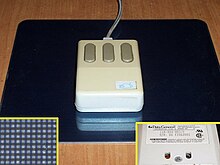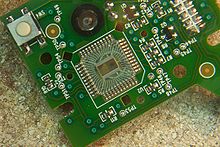Optical mouse
An optical mouse is a pointing device introduced in information technology in 1987. In contrast to the previously common computer mice with roller balls , the optical mouse optically records the movement of the hand (and thus the mouse). The functionality is based on image processing . The mouse emits light downwards, which is reflected differently from the desk surface depending on its position. A sensor chip acts as a small camera, combined with a computing unit integrated in the mouse. The optical sensor determines the movement of the mouse from the image shift.
functionality
The mouse pad is illuminated by a light emitting diode (LED) or a laser diode ( laser mouse ). The image reflected by the base is recorded (via a lens) by the mini camera of the sensor chip. The resolution of the mini camera ranges from 16 × 16 to 30 × 30 pixels . The image information enters the digital signal processor (DSP) of the chip as a grayscale image . There the image is compared with the previous images and speeds and directions are first determined. Finally, the movement data (Δx and Δy values) are calculated from the speeds. Image correlation is used as the algorithm for calculating the speed , which since the late 1990s has been able to be implemented cost-effectively directly in a chip in the mouse. Sampling rates around 1500 images per second are common; the computing power of the DSP for determining the movement information is approx. 18 MIPS .
Exposure unit: LED or laser
In the first generation of optical mice, the light source consists of a red light-emitting diode. However, this technique has difficulties in determining the direction and speed of movement on monochrome, transparent, smooth or shiny surfaces. A further development consists in using a blue light-emitting diode instead of a red one. It should be more flexible than laser and conventional, optical mice in terms of the surface used. However, no glass or mirror surfaces can be used here either. This technique is known as bluetrack or blue wave.
In addition to the use of LEDs, mice with lasers as a light source were developed. With the laser mouse, the structures of the mouse pad are more clearly resolved. This means that the laser mouse can also be used on smooth, reflective surfaces that are unsuitable for LED mice, such as glass or mirror surfaces. However, they are also more sensitive to bumps, blemishes and other surface defects.
Historical

Originally, the technology of position determination using a camera from Hewlett Packard was developed for the navigation of aircraft. However, problems with unstable lighting conditions and falling costs of satellite-based navigation have prevented successful marketing. Its use as a mouse sensor ultimately made the technology a great success. In a few years, the optical mice completely replaced the mechanical version.
When Hewlett Packard was later split up, the mouse sensors were initially continued by Agilent , meanwhile the division of the HP group belongs to Avago Technologies .
There is currently only one licensee for optical mouse technology, ST Microelectronics . However, Avagotech is constantly pursuing plagiarism of this technology.
Precursors of the current optical mice already existed in the 1980s and early 1990s. These required a special mouse pad with a grid structure. The vertical and horizontal grid lines were printed with different colors, and these mice had two reflex light barriers , one of which worked with red and the other with infrared light. The resolution of these mice was comparatively low, but they could be used very precisely, and the lack of mechanically moving parts was an advantage for the user.
Web links
- Optical mouse-cam - read image data from an optical mouse at spritemods.com ( English )
Individual evidence
- ↑ In 1987 the first advertisements for the optical mouse appeared in the computer press. Manufacturers were companies such as Microsoft , IBM or MSC Technologies. The latter advertised in the December 1987 issue of Byte magazine : Why you should buy a mouse with no moving parts.
- ↑ IntelliMouse: A New Approach and a Smarter Mouse. Microsoft, accessed February 14, 2014 .
- ↑ Patent US6433780 : Seeing eye mouse for a computer system. Applied January 2, 2001 , published August 13, 2002 , Applicant: Agilent Technologies, Inc., Inventors: Gary B. Gordon, Derek L. Knee, Rajeev Badyal, Jason T. Hartlove.
- ↑ http://www.microsoft.com/hardware/de-de/bluetrack-technology (September 26, 2015)
- ↑ http://www.microsoft.com/hardware/de-de/bluetrack-technology (September 26, 2015)
- ↑ https://www.hama.com/00053869/hama-optische-maus-cino-schwarz (September 26, 2015)

